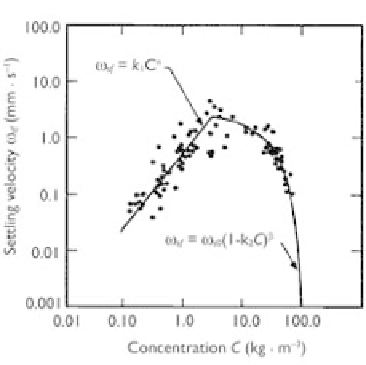Geoscience Reference
In-Depth Information
Table 11.1
Parameters
n
d
and
d
r
of flocculation factor
Authors
Experiment conditions
n
d
d
r
(mm)
Migniot (1968)
Muddy sediments, salinity
=
30 ppt,
1.8
0.0215
sediment concentration
=
10 kg
·
m
−
3
Qian (1980)
River sediments,
2.0
0.011
sediment concentration
=
30 kg
·
m
−
3
Huang (1981)
Lianyun Harbor mud, salinity
=
30 ppt,
1.9
0.022
0.08-1.8 kg
·
m
−
3
sediment concentration
=
Dixit
et al
. (1982)
No salinity,
1.8
0.012
1.2-11 kg
·
m
−
3
sediment concentration
=
of the dispersed particles. This range of settling velocity is equivalent to the size range
of medium-to-coarse silt particles.
Sediment concentration
Flocculation is highly related to sediment concentration, as shown in Fig. 11.5 (Thorn,
1981; Mehta, 1986). At low sediment concentrations, as the sediment concentration
increases, the floc settling velocity increases, due to the intensification of flocculation
by increasing the collision probability. As the sediment concentration increases fur-
ther, the floc settling velocity decreases, due to the effect of hindered settling and the
formulation of large floc structures. At very large concentrations, a large number of
particles form large-scale floc matrices and, thus, the floc settling velocity becomes
very small and even reduces to zero temporarily. The water and sediment mixture
tends to be fluidized and becomes a non-Newtonian fluid.
The floc settling velocity in Fig. 11.5 is based on measurements in a settling column
using the mud in saltwater from the Severn Estuary, England (Thorn, 1981). The curve
Figure 11.5
Floc settling velocity as function of sediment concentration (Thorn, 1981; Mehta, 1986).




